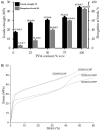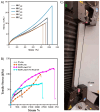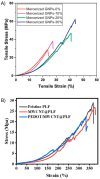Survey of Sustainable Wearable Strain Sensors Enabled by Biopolymers and Conductive Organic Polymers
- PMID: 40277671
- PMCID: PMC12027174
- DOI: 10.3390/gels11040235
Survey of Sustainable Wearable Strain Sensors Enabled by Biopolymers and Conductive Organic Polymers
Abstract
The field of wearable sensors has evolved with operating devices capable of measuring biomechanics and biometrics, and detecting speech. The transduction, being the conversion of the biosignal to a measurable and quantifiable electrical signal, is governed by a conductive organic polymer. Meanwhile, the conformality of skin to the substrate is quintessential. Both the substrate and the conductive polymer must work in concert to reversibly deform with the user's movements for motion tracking. While polydimethylsiloxane shows mechanical compliance as a sensor substrate, it is of environmental interest to replace it with sustainable and degradable alternatives. As both the bulk of the weight and area of the sensor consist of the substrate, using renewable and biodegradable materials for its preparation would be an important step toward improving the lifecycle of wearable sensors. This review highlights wearable resistive sensors that are prepared from naturally occurring polymers that are both sustainable and biodegradable. Conductive polythiophenes are also presented, as well as how they are integrated into the biopolymer for sensors showing mechanical compliance with skin. This polymer is highlighted because of its structural conformality, conductivity, and processability, ensuring it fulfils the requirements for its use in sensors without adversely affecting the overall sustainability and biodegradability of resistive sensors. Different sustainable resistive sensors are also presented, and their performance is compared to conventional sensors to illustrate the successful integration of the biosourced polymers into sensors without comprising the desired elasticity and sensitivity to movement. The current state-of-the-art in sustainable resistive sensors is presented, along with knowledge of how biopolymers from different fields can be leveraged in the rational design of the next generation of sustainable sensors that can potentially be composted after their use.
Keywords: PEDOT; biopolymers; resistive sensor; sustainable sensors; wearable sensors.
Conflict of interest statement
The authors declare no conflicts of interest.
Figures









References
-
- Verma R.P., Sahu P.S., Rathod M., Mohapatra S.S., Lee J., Saha B. Ultra-Sensitive and Highly Stretchable Strain Sensors for Monitoring of Human Physiology. Macromol. Mater. Eng. 2022;307:2100666. doi: 10.1002/mame.202100666. - DOI
-
- Liza L., Kabir M.H., Jiang L., Jerrams S., Chen S. The Technology of Wearable Flexible Textile-Based Strain Sensors for Monitoring Multiple Human Motions: Construction, Patterning and Performance. Sens. Diagn. 2023;2:1414–1436. doi: 10.1039/d3sd00194f. - DOI
-
- Sun S., Liu Y., Chang X., Jiang Y., Wang D., Tang C., He S., Wang M., Guo L., Gao Y. A Wearable, Waterproof, and Highly Sensitive Strain Sensor Based on Three-Dimensional Graphene/Carbon Black/Ni Sponge for Wirelessly Monitoring Human Motions. J. Mater. Chem. C. 2020;8:2074–2085. doi: 10.1039/C9TC04537F. - DOI
-
- Lozoya-Santos J.D.-J., Félix-Herrán L.C., Tudón-Martínez J.C., Vargas-Martinez A., Ramirez-Mendoza R.A. Design and Implementation of an Iot-Oriented Strain Smart Sensor with Exploratory Capabilities on Energy Harvesting and Magnetorheological Elastomer Transducers. Appl. Sci. 2020;10:4387. doi: 10.3390/app10124387. - DOI
Publication types
Grants and funding
LinkOut - more resources
Full Text Sources
Research Materials

